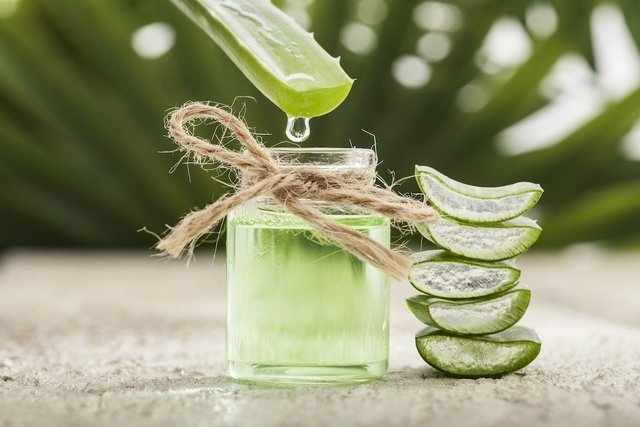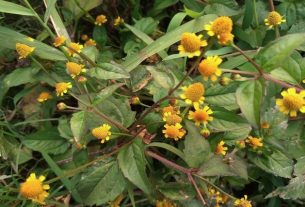Aloe vera is a medicinal plant of the species Aloe vera or Aloe Barbadensis miller, rich in mucilaginous polysaccharides, fibroblast growth hormone, minerals and substances with anti-inflammatory, antiseptic and healing properties, which is why, since ancient times, it has been indicated for the home treatment of first or second degree burns, being able to alleviate the pain and stimulate skin recovery.
The part of aloe vera used for burns is the gel inside the two leaves, and care must be taken not to use the bark of the aloe leaf, which has toxic effects. Before using aloe vera gel, it is important to do an allergy test by applying a little of the gel to the back of your hand and waiting for about 2 hours. If the skin becomes red or irritated, it is not recommended to use aloe vera gel for skin burns.
Aloe vera can be purchased in health food stores, compounding pharmacies and some open-air markets. Furthermore, this plant can also be easily grown at home, as it does not need special care.

Why is aloe vera good for burns?
Aloe vera is considered good for burns because it contains substances such as:
- Mucilaginous polysaccharides such as glucomannans and mannans: increase skin moisture and stimulate the production of collagen and elastin fibers, leaving the skin more elastic, less wrinkled and smoother;
- Fibroblast growth hormone such as gibberellin: interact with fibroblast growth receptors, stimulating their activity and proliferation, resulting in increased collagen production, and helping with skin regeneration and healing;
- Anti-inflammatories, such as C-glycosyl chromone, aloin and aloesin: reduce the production of prostaglandins, responsible for inflammation, relieving symptoms;
- Antihistamines, such as barbaloin: reduces redness and swelling and skin discomfort;
- Antiseptics, such as barbaloin, lupeol, salicylic acid, urea nitrogen, cynic acid, phenols and sulfur: help keep the skin clean and prevent infections by fungi, bacteria or viruses;
- Painkillers, such as aloin: helps to alleviate the symptoms of skin burns, such as pain or discomfort, and also helps with skin healing;
- Minerals, such as zinc: It has an astringent action that helps close the skin pores.
The most beneficial results from aloe vera were observed when creams containing this plant in their composition were applied to the skin, accelerating the healing and re-epithelialization process, relieving burn symptoms. Furthermore, in a study, it was found that aloe vera has mainly beneficial effects in the treatment of first and second degree burns. Despite this, more studies are needed and the use of aloe vera should only be done under medical recommendation.
How to use aloe vera on burns
To use aloe vera to treat burns, you must:
- Cut an aloe leaf in the middle;
- Remove the gel from the inside of the leafwhich is the transparent part found in the fleshy part of the leaf;
- Apply the gel in a thin layer over the burnavoiding places where there are any wounds or openings in the skin.
Aloe vera gel should only be applied to intact skin because it can end up facilitating the accumulation of bacteria, which can lead to an infection in the area.
Aloe vera can also be used in the form of creams or lotions sold in pharmacies and some supermarkets and, in these cases, the skin must also be intact. In any case, aloe vera can be applied 3 to 4 times a day to speed up skin healing.
Who shouldn’t use
Aloe vera should not be used orally, but only on burned skin, as it can cause liver damage, especially if there are traces of the external part of the leaf in the gel. Therefore, aloe vera should not be ingested without guidance from a doctor or herbalist.
Furthermore, aloe vera should not be used on third-degree burns or open wounds and should also not be used by people who are allergic to this medicinal plant, which is why it is important to carry out an allergy test before using it.
The use of aloe vera by children, pregnant or breastfeeding women should be avoided.
Bibliography
- AKEV, N.; et al. Twenty years of research on Aloe ver. 45. 2; 191-215, 2015
- HEKMATPOU, D.; et al. The Effect of Aloe Vera Clinical Trials on Prevention and Healing of Skin Wound: A Systematic Review. Iran J Med Sci. 44. 1; 1–9, 2019

Sign up for our newsletter and stay up to date with exclusive news
that can transform your routine!
Warning: Undefined array key "title" in /home/storelat/public_html/wp-content/plugins/link-whisper-premium/templates/frontend/related-posts.php on line 12
Warning: Undefined array key "title_tag" in /home/storelat/public_html/wp-content/plugins/link-whisper-premium/templates/frontend/related-posts.php on line 13



